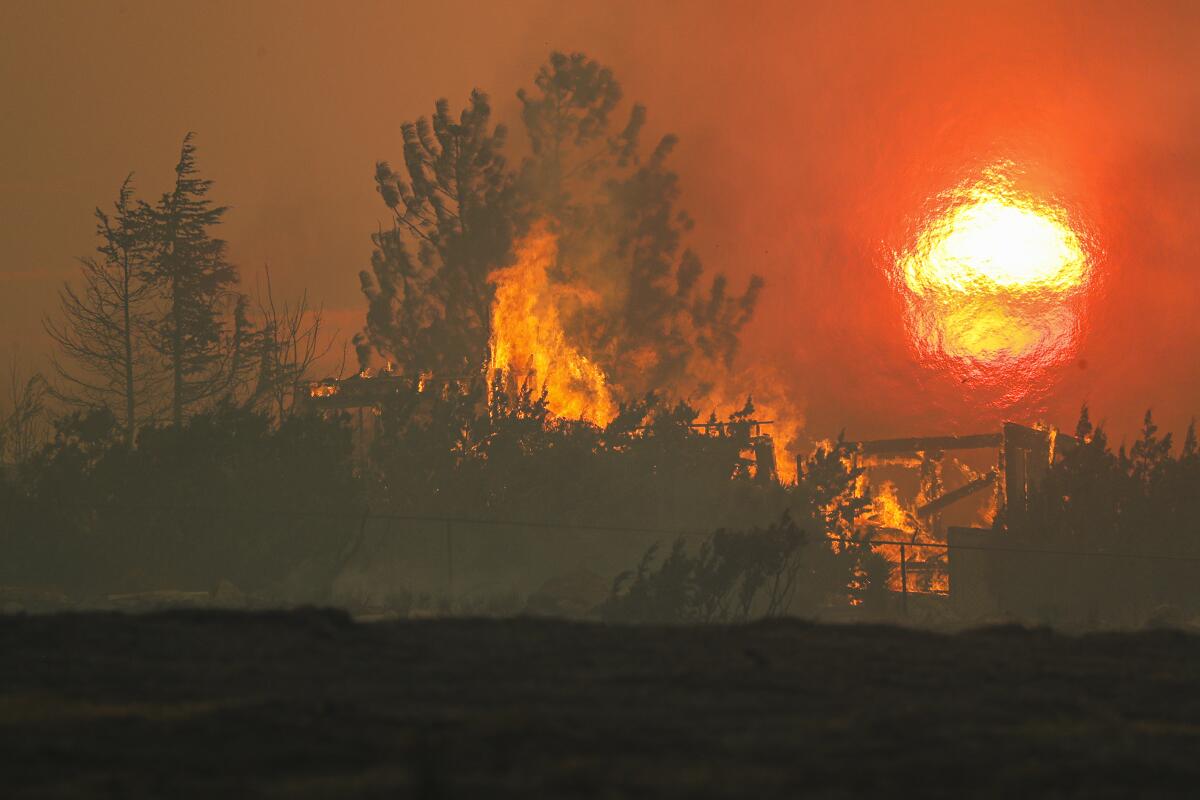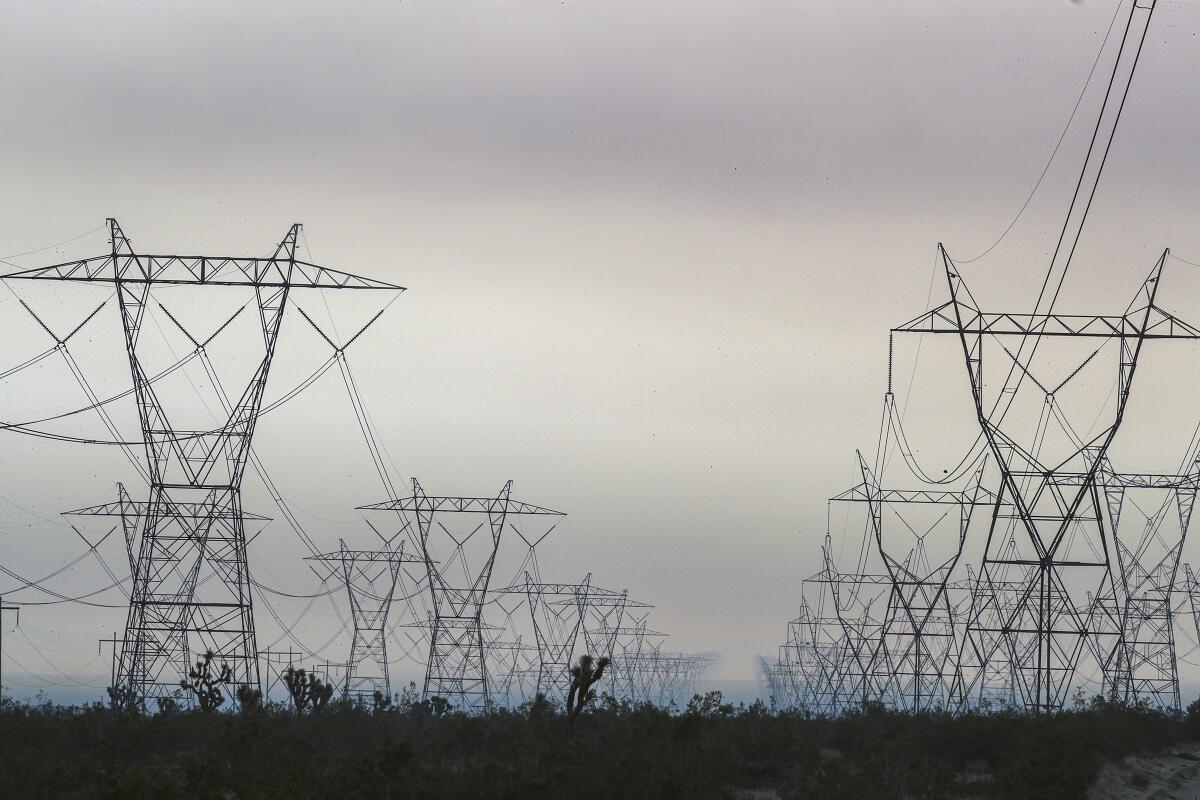Former employee sues SoCal Edison after losing his home in Bobcat fire

- Share via
Richard Passmore was celebrating his fourth month of retirement from Southern California Edison when flames from the Bobcat fire began creeping toward his Juniper Hills home.
The 63-year-old watched as smoke rolled into the valley. He knew it was time to leave when he heard bulldozers creating fire breaks and saw planes dropping retardant on the other side of his hill.
From the safety of a friend’s house, he watched as flames lapped at his neighborhood through aerial footage on TV. Another friend called him a few days later with a report.
“It’s gone, Rich,” his friend said.
Passmore’s home, along with more than 80 others in the Antelope Valley, was destroyed by the aggressive fire, which burned through more than 155,000 acres after igniting Sept. 6.
Now, Passmore is the lead plaintiff in the first lawsuit against SoCal Edison — his former employer — for its alleged role in the blaze.
“Mr. Passmore devoted his entire 36-year career working diligently as a meter reader for Edison, only to have Edison burn down his home after he retired,” the court documents say.
The complaint was filed Thursday in Los Angeles Superior Court.

Edison has been at the center of the investigation into the fire’s start since September, when federal officials first began to focus on utility equipment near Cogswell Dam.
Reached by phone Thursday afternoon, SoCal Edison spokesman Chris Abel said the agency was not aware of the lawsuit.
“We at Edison keep in our thoughts all those who have been affected, and currently are being affected, by wildfire,” Abel said. “The safety of the public, our customers, our communities, and our employees and contractors is always our top priority.”
In October, the company filed a letter with the California Public Utilities Commission notifying regulators that tree branches in the vicinity of the dam may have created a spark when they came into contact with a 23-foot conductor line owned by Edison.
The company had previously said a circuit at its Dalton Substation “experienced a relay operation,” indicating a disturbance just five minutes before the fire was first reported.
“The fire was caused by, ironically, the company that I retired from,” Passmore said.
The Bobcat fire destroyed at least 170 homes and structures as it burned for weeks, according to data from the U.S. Forest Service. It also forced thousands of evacuations, choked the region with ash and smoke and, at one point, came within five feet of the iconic Mt. Wilson Observatory.
It was one of the largest fires in L.A. County history.
Edison filed its report with the utilities commission after Forest Service investigators requested some of their equipment for inspection, according to the letter. A representative from the Forest Service said Thursday that its investigation is ongoing.
The lawsuit alleges that Edison failed to maintain clearances between its energized conductors and vegetation, including dead and rotten trees, as required by code.
“Edison had a duty to properly construct and maintain its electrical infrastructure and ensure that surrounding trees and vegetation were trimmed and kept at a safe distance,” the suit says. “Had Edison acted responsibly, the Bobcat fire could have been prevented.”
The suit also said the agency failed to implement a public safety power shutoff that could have prevented a fire from sparking after the National Weather Service issued warnings about strong winds, high temperatures and low humidity around the time of the fire.
Passmore said purchased his home in 1997 and paid it off 3 ½ years ago. He canceled his bank-required homeowner’s insurance when the loan was paid off, and was planning to sell the property and move to Idaho.
“That’s still my plan,” he said Thursday, “but now I just have to go about it in a different route.”
Five additional plaintiffs were named in the lawsuit, including two brothers whose Llano home was destroyed by the blaze along with livestock and an urn containing the ashes of their mother. Three other Juniper Hills residents are claiming damages from the fire as well.
In California, utilities can be found liable for wildfire damages under the state’s inverse-condemnation law, which is the “flip side of eminent domain,” said Passmore’s attorney, Alexander “Trey” Robertson, whose law firm filed the suit.
“Where a government or quasi-government agency does something to damage your land, like burn it from a wildfire, they then have to pay fair market value for the property that they damaged or destroyed,” he said.
Attempts by utility companies to challenge inverse condemnation through the courts have failed, Robertson said, although the state did push for the establishment of a $10 billion wildfire fund in 2019 to help keep utility companies from going bankrupt.
Edison, a privately owned public utility, is one of the largest electric utilities in the nation, according to the suit. Robertson said the complaint also allows room for subcontractors, such as tree-trimmers and vegetation managers, to be added as co-defendants if they are found to have played a role.
Robertson is also representing about 1,700 plaintiffs in other cases against Edison for its alleged role in the 2018 Woolsey fire, which burned 96,000 acres, and the 2017 Thomas fire, which burned 281,000 acres.
Combined, the two fires destroyed more than 2,700 structures and killed at least five people, according to numbers from the California Department of Forestry and Fire Protection.
Abel, the Edison spokesman, said that the company has reached some settlement agreements around the Thomas and Woolsey fires, and that they will “continue to explore reasonable settlement opportunities with other parties.”
“No admission of wrongdoing or liability was made in reaching these settlements,” he said.
But despite damages suffered from the Bobcat blaze, Robertson said his client does not hold ill-will against his former employer.
“He thought it was a good company to work for and he enjoyed his time there,” Robertson said. “He just said, ‘Hey, they’ve got insurance, and if they started this fire that burned my house down, I’m going to look to them to make me whole.’ He has a pretty good perspective about it.”
Passmore said he lost nearly everything, from appliances and personal items to “blue jeans and undergarments” in the fire, and he doubts he will be able to collect on all of his losses. So far, he has relied on the support of loved ones, along with his own spiritual values, to get through the ordeal.
“Things happen — people get sick, people get in accidents, and you just have to deal with whatever your circumstance is,” he said. “We all have a load to carry.”
But the pain of losing his home has been compounded by the coronavirus pandemic, he said, and by a lack of guidance from Los Angeles County officials, who won’t return his calls or let him begin cleanup at his red-tagged property.
He is staying with friends in Long Beach.
“There’s a whole lot of people who lost everything they had in recent fires,” Passmore said. “This club is getting to be pretty big. I’m not alone in this.”
Times staff writer Joseph Serna contributed to this report.
More to Read
Sign up for Essential California
The most important California stories and recommendations in your inbox every morning.
You may occasionally receive promotional content from the Los Angeles Times.














